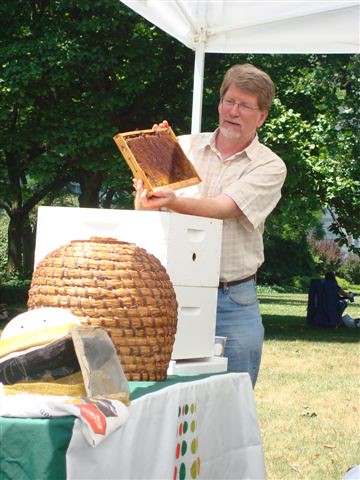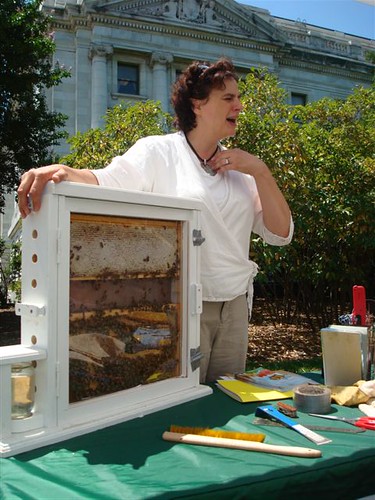Did you know that less than one in ten thousand bees sting? Most of the stings that you and I have experienced are at the hands of wasps and hornets and their relatives; they are hunters that sting several times a day. Bees, however, only sting when they feel threatened and die shortly thereafter. It’s easy to tell whether you’ve been stung by a bee: bees leave their stinger behind. If there’s no stinger left and just a welt, you were stung by a wasp or hornet.
This is the first fact that Dr. Jeff S. Pettis told us today in the People’s Garden workshop. Dr. Jeff S. Pettis, the research leader of the USDA-Agricultural Research Service Bee Research Laboratory in Beltsville, Maryland, came with his assistant Toni Burnham, a beekeeper in Washington D.C., and told us lots of tips, tricks, facts, and stories about beekeeping.
People and bees have been coexisting for over 6,000 years. There are cave paintings dating to 1300 BC that show people robbing honey from bees’ nests. In Europe, when people would find a tree bees were living in, they would mark this “bee tree” to come back and get honey. Or, some would chop the tree down and relocate it in their backyard, to ensure they did get the honey! Today, we have movable frame hives that people can keep bees in. This allows us to observe the bees, and the size of the frames stops the bees from cross-combing their hives, so the wax and honey are easy to access without damaging the bees’ hive.
Keeping bees in the city is not a difficult hobby. “Beekeeping is as difficult as you make it,” Toni Burnham told us. Because there is a high diversity of flowering trees and plants in an urban environment, bees can be happier and healthier in an urban environment even over suburbia. Remember though, while bees have been existing with us humans for quite some time, by no means have we domesticated them. There can be between thirty and sixty thousand bees in a hive, and they are sharing the habitat with us.
The biology and behavior of bees is fascinating. You can learn a lot about their lifestyles by simply observing their activities throughout the day and over the course of the seasons. While we were in the workshop, some scout bees from a nearby hive came to investigate some honey we had. After sampling it, they will go back to their hive and perform a dance for the other bees. Bees don’t lie, different steps and patterns in the dance will indicate whether the honey they found is something spectacular, or just so-so. Additionally, the bees always know exactly where to go by what patterns are made in the dance!
Keeping bees is not only a fun hobby, but it provides pollinators and plays a major role in supporting the ecosystem. Bees, birds, bats, and butterflies play a vital role in pollination of flowers and our food supply. If you are interested in starting your own honeybee hive, check your local area for beekeeping clubs. They can provide you with what information and resources you will need to keep bees in your area.

Dr. Pettis showed us a frame from a beehive and explained the functions of the different parts within the hive.

Toni Burnham brought an observation hive to observe bees inside it in action.
